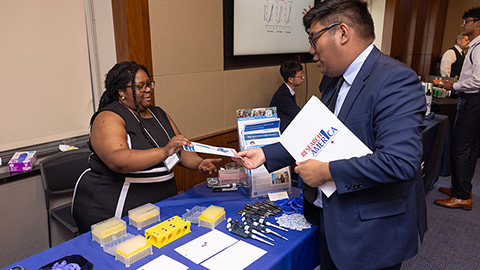ARPA-H threatens the biomedical innovation pipeline
The creation of the Advanced Research Projects Agency for Health has put funding for the National Institutes of Health, and therefore the fundamental research it sustains, in jeopardy.
The president’s fiscal year 2023 budget proposal, released in late March, requests a sizeable increase in NIH funding — almost all of which is intended for ARPA-H. That would leave just a $275 million boost to the NIH’s base budget, which is what funds basic research by the extramural research community.
Such a nominal increase will not keep up with inflation or the rising costs of conducting research, so, if Biden’s request for fiscal 2023 comes to pass, we can expect the American research enterprise’s output to decline and the careers of scientists and training of the next generation of researchers to stall.
The scientific community and science policy advocates are asking: What role does the federal government have in funding translational and applied research versus basic research? And how do we, as science policy advocates, call for a balanced approach?
How we got here
Biden proposed the new agency in early 2021. He said it would support transformative high-risk, high-reward research and “drive biomedical and health breakthroughs that would provide transformative solutions for all patients.”
Subsequently, lawmakers introduced several bills in Congress laying out ARPA-H’s goals and activities, governing structure and hiring authorities.
U.S. Rep. Anna Eshoo, D-Calif., introduced H.R. 5585 in the summer of 2021 to establish ARPA-H outside and completely independent from the NIH. However, in early March of this year, the U.S. Senate Health, Education, Labor and Pensions Committee sought to create ARPA-H within the NIH using pandemic preparedness legislation. Neither of those bills progressed. (On May 18, the House Energy and Commerce Committee voted 53–3 to pass H.R. 5585 out of the committee, allowing the bill to proceed to the House for consideration, but it’s likely the bill will lag on the House floor.)
Congress passed and Biden signed into law on March 15 the 2022 spending bill establishing ARPA-H and allocating $1 billion for it. That bill gave the U.S. Department of Health and Human Services the power to decide whether the new agency would be independent or part of the NIH.
In late March, HHS Secretary Xavier Becerra decided to place ARPA-H within the NIH but require the director of ARPA-H to report directly to the HHS secretary instead of to the NIH director.
Biden’s FY23 budget proposal, submitted to Congress on March 28, asks for about $62.5 billion for the NIH. By comparison, the FY22 budget was $45 billion. At first glance, this seems like a significant increase, but of the $17.5 billion difference, a little over $12 billion is set aside for pandemic preparedness, $5 billion is set aside for ARPA-H and some change is set aside for a handful of other specific activities. And just like that, any hope for a basic research boost vanishes.
The benefits of basic research
Basic scientific research, also known as bench, preclinical or fundamental research, is curiosity-driven investigation, often motivated by a gap in knowledge. By contrast, applied research is centered on filling a need established at the onset of a project.
Basic research expands the knowledge base needed for breakthrough scientific progress. Without basic scientific research, there would be no science to apply, thereby forgoing any innovative breakthroughs, treatments or therapies.
Basic scientific research does the economy a world of good. According to the International Monetary Fund, greater investment in basic scientific research, as opposed to applied research, is more likely to “drive stronger longer-term economic growth, induce a knowledge spillover effect, increase productivity and encourage more public-private collaboration.”
The catch is that the federal government must fund basic scientific research. The private sector has little to no incentive to invest in it because the direct returns are often smaller than the returns to the economy as a whole. This is why federal support for basic research projects is crucial; the lack of direct commercial applications from basic research projects and the uncertainty of project success deters business from funding this type of research — even though it’s absolutely necessary for the rest of the innovation pipeline to thrive.

Basic research and the innovation pipeline
Only about 17% of all research and development conducted in the U.S. is for basic research; the rest is for applied research and experimental development. And almost half of all funding for basic scientific research is provided by the federal government. To highlight the importance of federally funded basic research, science policy experts and scientists have attempted to quantify the concrete return.Danielle Li, an associate professor at the Massachusetts Institute of Technology Sloan School of Management traced funding from NIH grants to associated publications, patents and products. She found that $10 million in NIH funding generates about $3.5 to $28 million in value of drug sales. In addition, on average, about one-third of NIH grants result in research that is cited by a private sector patent. These estimates and others of financial returns associated with NIH funding demonstrate the incredible value that federally funded basic scientific research (among others) has on the larger innovation ecosystem.
The major conclusion that Li drew was that “fewer drugs would be developed in the absence of NIH funding.” And, it’s worth noting, Li’s study primarily focused on the health benefits; her study did not take into account the training NIH funds for the next generation of scientists or other spillover effects that ripple throughout the country.
Considering that over half of the NIH’s research funding supports basic research and the crucial role this funding has in fostering innovation, it’s disheartening when leaders fixate on translational research at the expense of basic research.
While translational research at ARPA-H very well may yield direct outcomes that will help patients battling devastating diseases, such as cancer or Alzheimer’s, we can’t put the cart before the horse. Translational research can’t happen without sustained, reliable investments in basic scientific research.
We’ve written about our concerns regarding ARPA-H multiple times (here in our comment letter, here in an article about Biden’s proposed budget for fiscal year 2023 and here in our endorsement statement for H.R. 5585 that would ensure ARPA-H's autonomy). And unfortunately, Biden’s proposed budget for fiscal year 2023 has only realized some of our concerns.
We’re urging policymakers to separate the budget of NIH from the budget of ARPA-H and ensure the NIH’s budget increases more than 0.6%.
Next steps
We’ve joined numerous other groups — such as the Coalition for Health Funding, Ad Hoc Group for Medical Research, the Leaders Engaged on Alzheimer’s Disease Coalition and Research!America — advocating for sustained investments in the NIH’s budget separate from funding for ARPA-H and for any funding for ARPA-H to supplement, rather than supplant, investments to the NIH.
As long as funding for ARPA-H is clearly separated from funding for NIH’s core functions, the agency could invigorate the innovation pipeline and lead to incredible discoveries.
The Biden administration has taken recommendations from the scientific community on how it intends to create and run the agency. From July 14 to Aug. 18, 2021, the White House Office of Science and Technology Policy and the NIH held 15 listening sessions with stakeholders across the scientific community to seek input.
The administration has appropriately modified the mission of ARPA-H in a few ways:
-
ARPA-H will promote and advance specific technological capabilities instead of specific diseases.
-
It will focus on rapid and accessible early detection, diagnosis and treatment platforms.
-
It will prioritize programs that consider individuals holistically.
-
It mission will embrace equity and diversity as a cornerstone (as the ASBMB public affairs department recommended back in July).
It bears repeating: There will be no medical breakthroughs or revolutionary discoveries without sustained investments in basic scientific research. We urge policymakers to prioritize, not plunder, funding for the NIH, which is laying the foundation for what's to come at ARPA-H.
Enjoy reading ASBMB Today?
Become a member to receive the print edition four times a year and the digital edition monthly.
Learn moreGet the latest from ASBMB Today
Enter your email address, and we’ll send you a weekly email with recent articles, interviews and more.
Latest in Policy
Policy highlights or most popular articles

Embrace your neurodivergence and flourish in college
This guide offers practical advice on setting yourself up for success — learn how to leverage campus resources, work with professors and embrace your strengths.

ASBMB honors Lawrence Tabak with public service award
He will deliver prerecorded remarks at the 2025 ASBMB Annual Meeting in Chicago.

Summer internships in an unpredictable funding environment
With the National Institutes of Health and other institutions canceling summer programs, many students are left scrambling for alternatives. If your program has been canceled or delayed, consider applying for other opportunities or taking a course.

Black excellence in biotech: Shaping the future of an industry
This Black History Month, we highlight the impact of DEI initiatives, trailblazing scientists and industry leaders working to create a more inclusive and scientific community. Discover how you can be part of the movement.

ASBMB releases statement on sustaining U.S. scientific leadership
The society encourages the executive and legislative branches of the U.S. government to continue their support of the nation’s leadership in science.

ASBMB and advocacy: What we accomplished in 2024
PAAC members met with policymakers to advocate for basic scientific research, connected some fellow members with funding opportunities and trained others to advocate for science.

